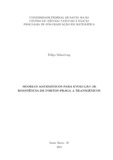| dc.creator | Schardong, Felipe | |
| dc.date.accessioned | 2021-11-19T15:22:42Z | |
| dc.date.available | 2021-11-19T15:22:42Z | |
| dc.date.issued | 2021-04-30 | |
| dc.identifier.uri | http://repositorio.ufsm.br/handle/1/22889 | |
| dc.description | Título conforme histórico escolar: Modelos matemáticos para evolução de resistência de pragas a transgênicos | por |
| dc.description.abstract | Genetically Modified Organisms (GMOs) are organisms that have undergone artificial
changes in their genetic material. We can cite as an example of GMOs, genetically modified
crops or, simply, transgenic crops. The main objectives of these crops are to meet
certain needs, which conventional crops do not offer, such as: resistance to diseases, insects
and chemical insecticides, increased production, drought tolerance, among others.
However, the intense use of transgenic crops can lead to some problems that make this technology
inefficient, among them, the main one is related to the development of resistance
to the insecticidal toxins of these cultures, by the pest insects. One of the ways found
to delay or even prevent insects from becoming resistant to toxins is to make use of the
refuge area, which consists of planting a variety without transgenic technology. In this
work, we formulated discrete models to describe the evolution of resistance to transgenic
crops observed in insect pest populations. The models are formulated in terms of Difference
Equations - in which space is treated implicitly - and Coupled Map Lattices - which
explicitly consider the spatial variable. The proposed models, allows us to analyze the
effects of the size and structure of the refuge on the evolution of resistance to transgenic
cultures. Our results indicate that the larger the size of the refuge, the lower the frequency
of the allele that confers resistance. In general, the configurations around the refuge and
block resulted in a lower rate of increase in the frequency of the resistant allele when
considering a local movement. On the other hand, when the movement is non-local, the
best results, in the sense of delaying the evolution of resistance, were obtained with the
refuge distributed at random and in bands. In addition, the fitness that individuals show,
both in the refuge area and in the transgenic area, has a great influence on the evolution
of resistance to proteins with an insecticidal effect introduced in transgenic cultures. | eng |
| dc.description.sponsorship | Coordenação de Aperfeiçoamento de Pessoal de Nível Superior - CAPES | por |
| dc.language | por | por |
| dc.publisher | Universidade Federal de Santa Maria | por |
| dc.rights | Attribution-NonCommercial-NoDerivatives 4.0 International | * |
| dc.rights.uri | http://creativecommons.org/licenses/by-nc-nd/4.0/ | * |
| dc.subject | Evolução da resistência | por |
| dc.subject | Modelos discretos | por |
| dc.subject | Equações a diferenças | por |
| dc.subject | Redes de mapas acoplados | por |
| dc.subject | Evolution of resistance | eng |
| dc.subject | Discrete models | eng |
| dc.subject | Difference equations | eng |
| dc.subject | Coupled map lattices | eng |
| dc.title | Modelos matemáticos para evolução de resistência de insetos-praga a transgênicos | por |
| dc.type | Dissertação | por |
| dc.description.resumo | Organismos Geneticamente Modificados (OGM) são organismos que sofreram alterações
artificiais em seu material genético. Podemos citar como um exemplo de OGM, as culturas
geneticamente modificadas ou, simplesmente, culturas transgênicas. Os principais
objetivos destas culturas são suprir certas necessidades, que as culturas convencionais
não oferecem, como por exemplo: resistência a doenças, insetos e inseticidas químicos,
aumento da produção, tolerância à seca, dentre outros. Porém, o uso intenso de culturas
transgênicas pode levar a alguns problemas que tornam esta tecnologia ineficiente, dentre
eles, o principal está relacionado ao desenvolvimento da resistência às toxinas inseticidas
destas culturas, por parte dos insetos-praga. Uma das formas encontradas para retardar
ou até mesmo evitar que os insetos se tornem resistentes às toxinas é fazer o uso
da área de refúgio, que consiste em plantar uma variedade sem a tecnologia transgênica.
Neste trabalho, formulamos modelos discretos para descrever a evolução da resistência
às toxinas inseticidas presentes em culturas transgênicas observadas em populações de
insetos-praga. Os modelos foram formulados em termos de Equações a Diferenças – em
que o espaço é tratado implicitamente – e Redes de Mapas Acoplados – que consideram
a variável espacial explicitamente. Por meio dos modelos propostos, analisamos os efeitos
da estrutura do refúgio sobre a evolução da resistência à cultura transgênica. Nossos
resultados indicam que quanto maior o tamanho do refúgio, menor a frequência do alelo
que confere a resistência. De um modo geral, as configuração em torno do refúgio e bloco
resultaram em uma menor taxa de aumento na frequência do alelo resistente quando consideramos
uma movimentação local. Por outro lado, quando a movimentação é não-local,
os melhores resultados, no sentido de retardar a evolução da resistência, foram obtidos
com as configurações de refúgio distribuído aleatoriamente e em faixas. Além disso, o
fitness que os indivíduos apresentam, tanto na área de refúgio quanto na transgênica têm
grande influência na evolução da resistência às proteínas com efeito inseticida introduzidas
nas culturas transgênicas. | por |
| dc.contributor.advisor1 | Mistro, Diomar Cristina | |
| dc.contributor.advisor1Lattes | http://lattes.cnpq.br/5816121630218752 | por |
| dc.contributor.referee1 | Neves, Armando Gil Magalhães | |
| dc.contributor.referee2 | Malaquias, José Bruno | |
| dc.creator.Lattes | http://lattes.cnpq.br/3779241300186566 | por |
| dc.publisher.country | Brasil | por |
| dc.publisher.department | Matemática | por |
| dc.publisher.initials | UFSM | por |
| dc.publisher.program | Programa de Pós-Graduação em Matemática | por |
| dc.subject.cnpq | CNPQ::CIENCIAS EXATAS E DA TERRA::MATEMATICA | por |
| dc.publisher.unidade | Centro de Ciências Naturais e Exatas | por |



